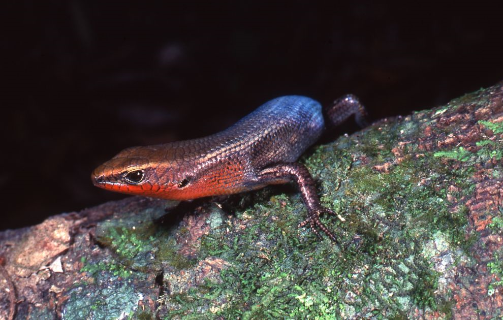
- Wet Tropics Management
- Legislative framework
- Management partnerships
- Sustainable Tourism Plan
- Threats to the Area
- Research and a Learning Landscape
- How can I help?
 One of the many reasons the Wet Tropics is a World Heritage area is because it has many plants and animals living in it that occur nowhere else on earth. Many endemic plants and animals are also rare, being found only in limited areas of the Wet Tropics. They may be restricted to certain habitats - cool, misty mountaintops, for instance like the Thornton Peak skink - or restricted to a limited geographic area like the Kuranda tree frog (Litoria myola). Some endemic species may be relatively common within their range like the musky rat kangaroo.
One of the many reasons the Wet Tropics is a World Heritage area is because it has many plants and animals living in it that occur nowhere else on earth. Many endemic plants and animals are also rare, being found only in limited areas of the Wet Tropics. They may be restricted to certain habitats - cool, misty mountaintops, for instance like the Thornton Peak skink - or restricted to a limited geographic area like the Kuranda tree frog (Litoria myola). Some endemic species may be relatively common within their range like the musky rat kangaroo.
Many of the rare Wet Tropics plants and animals are also endemic to the bioregion - found nowhere outside the Wet Tropics.
Over 2,800 plant species from 221 families are found in the Wet Tropics World Heritage Area (and about 4,000 plant species in the bioregion). More than 700 species (25 percent) are endemic to the Area. This a very high proportion and is due to a range of factors, including:

As far as plants go, scientists Dan Metcalfe and Andrew Ford (2009) calculate that within an area of 20,000 km2 the flora of the Wet Tropics bioregion (both rainforest and non-rainforest) comprises some 4,035 species in 1,369 genera. This compares favourably with that of New Caledonia (2,422 species in an area of 19,000 km2) and Costa Rica (5,250 species in an area of 51,000 km2). Globally, the Wet Tropics is second only to New Caledonia in the number of endemic genera conserved per unit area.
The rainforests of the Wet Tropics have more plant taxa with primitive characteristics than any other place on earth. Based on a modern phylogeny, Metcalfe and Ford (2009) calculate that of the 28 near-basal angiosperm lineages, 16 are represented in the rainforests of the Wet Tropics. This is a similar level of representation found for the flora of New Caledonia and Costa Rica. However, two primitive families, Austrobaileyaceae and Idiospermaceae are endemic to the Wet Tropics (Idiospermaceae is sometimes listed by some authorities as synonymous with the family Calycanthaceae). These 16 families (7 percent of the Wet Tropics’ families) contain 46 genera and 175 species. A further 636 Wet Tropics species are endemic to Australia.
Diversity and regional endemism within the fauna are also very high with, for example, 117 mammal species, including 14 endemic species and two monotypic endemic genera found in the region. There are 338 bird species of which 12 species are endemic. There are also 161 reptile species of which 30 species are endemic. The three endemic reptile genera are each represented by only a single species. The diversity of amphibians includes 60 species of which 27 are endemic species (Williams 2006; Stork et al 2011).
Many species in the Wet Tropics, particularly rainforest species, are naturally rare. Relative rarity of a species population is influenced by factors such as geographic range, local abundance and ubiquity of occurrence within the range of the species. It is often the case that species with a small geographic range have a low local abundance and are patchily distributed. Such characteristics make a species more susceptible to environmental change or disturbance and increase the potential for extinction. Thus rare species are often a focus for conservation management even when there are no obvious threats to their survival.
 References
ReferencesMetcalfe, D.J. & Ford, A.J. (2009). A re-evaluation of Queensland’s Wet Tropics based on primitive plants. Pacific Conservation Biology 15: 80–86
Stork, N.E., Goosem, S. & Turton, S.M. (2011). Status and Threats in the Dynamic Landscapes of Northern Australia’s Tropical Rainforest Biodiversity Hotspot: The Wet Tropics. In Zachos, F.E. & Habel, J.C. (eds). Biodiversity Hotspots. Distribution and Protection of Conservation Priority Areas. Springer-Verlag Berlin Heidelberg. pages 311 – 332.
Ward, G., Hawkes, T., (2015) Terrestrial Vertebrates of Australia's Wet Tropics. Sevare Publishing
Williams, S.E. (2006). Vertebrates of the Wet Tropics Rainforests of Australia: Species Distributions and Biodiversity. Cooperative Research Centre for Tropical Rainforest Ecology and Management. Rainforest CRC, Cairns, Australia (282 pp)